Analysis of Google's HR Practices, Culture, and Employee Engagement
VerifiedAdded on 2020/03/04
|8
|2441
|36
Report
AI Summary
This report provides an in-depth analysis of Google's human resource practices and their impact on employee engagement and organizational culture. It begins with an overview of Google's structure, mission, and vision, highlighting its unique organizational structure and the role of its HR strategy, known as people analytics. The report examines specific HR practices, including recruitment, employee benefits, training programs, and how they align with Maslow's hierarchy of needs to foster employee motivation. The core of the report focuses on employee engagement, defining its importance and illustrating how Google creates a motivating and transparent work environment. It also identifies key determinants and outcomes of employee engagement, proposing initiatives like strength development and engagement scorecards to further enhance Google's employee engagement. The report concludes by emphasizing Google's commitment to its employees and suggests strategies for continued improvement.
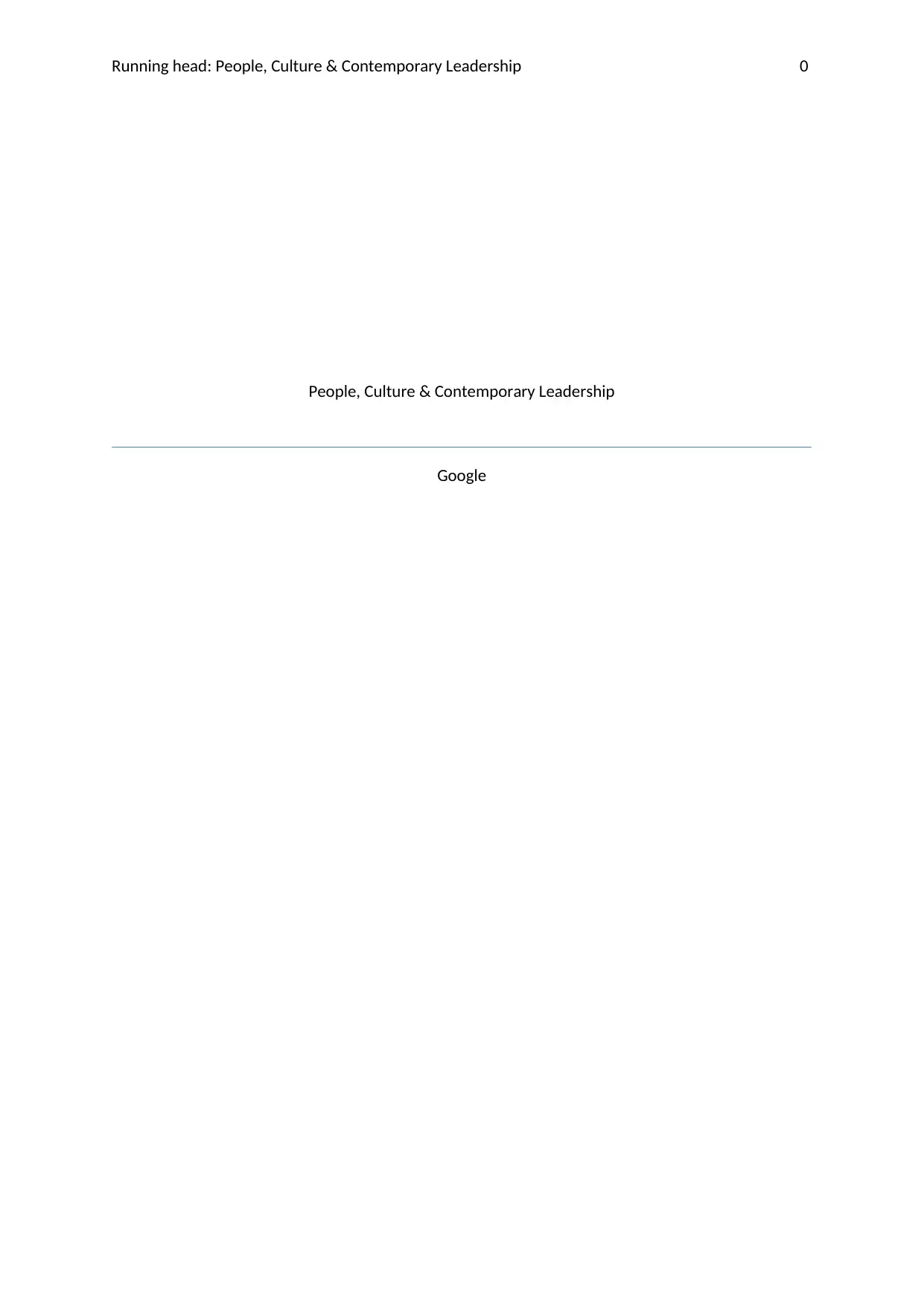
Running head: People, Culture & Contemporary Leadership 0
People, Culture & Contemporary Leadership
Google
People, Culture & Contemporary Leadership
Paraphrase This Document
Need a fresh take? Get an instant paraphrase of this document with our AI Paraphraser
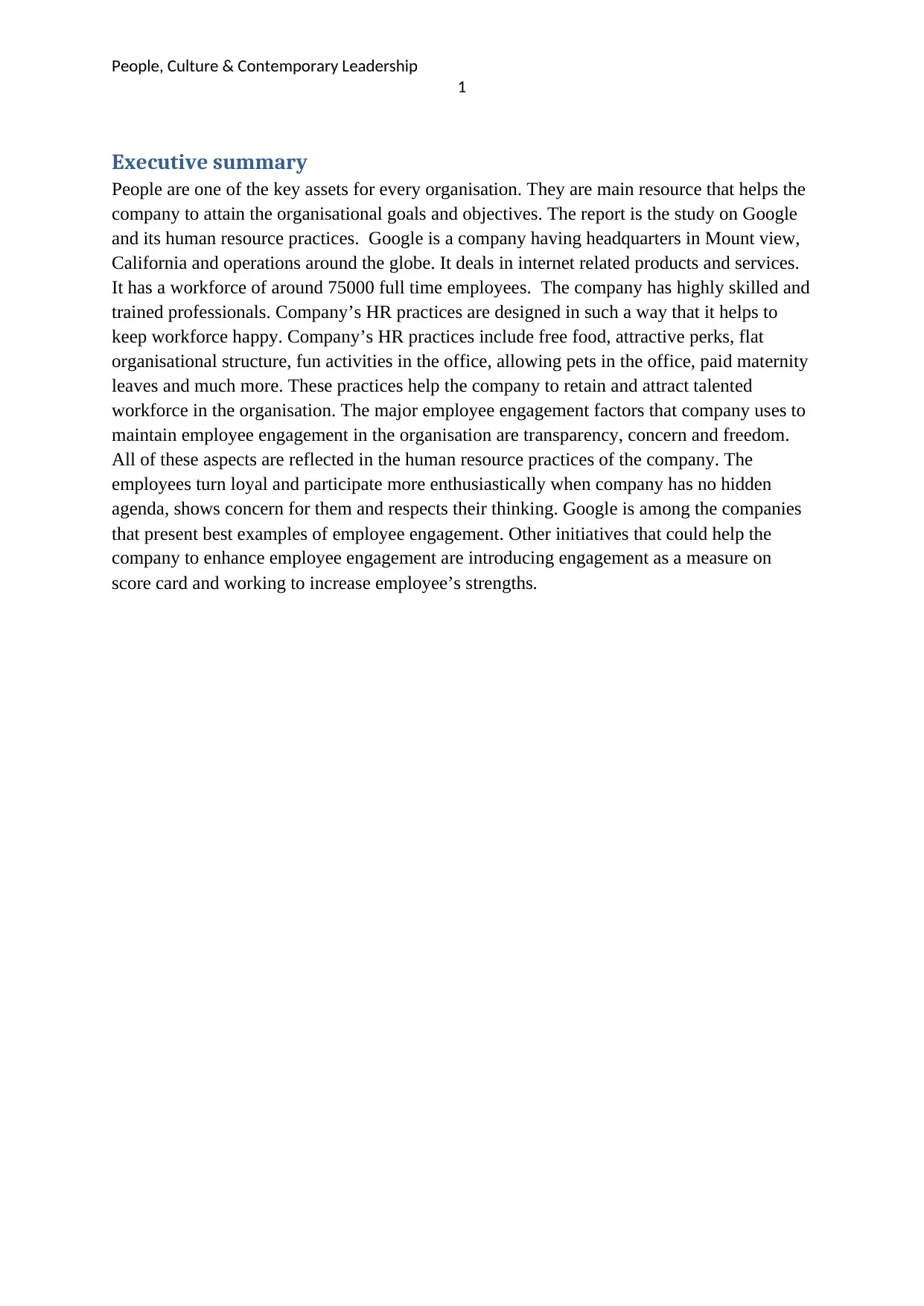
People, Culture & Contemporary Leadership
1
Executive summary
People are one of the key assets for every organisation. They are main resource that helps the
company to attain the organisational goals and objectives. The report is the study on Google
and its human resource practices. Google is a company having headquarters in Mount view,
California and operations around the globe. It deals in internet related products and services.
It has a workforce of around 75000 full time employees. The company has highly skilled and
trained professionals. Company’s HR practices are designed in such a way that it helps to
keep workforce happy. Company’s HR practices include free food, attractive perks, flat
organisational structure, fun activities in the office, allowing pets in the office, paid maternity
leaves and much more. These practices help the company to retain and attract talented
workforce in the organisation. The major employee engagement factors that company uses to
maintain employee engagement in the organisation are transparency, concern and freedom.
All of these aspects are reflected in the human resource practices of the company. The
employees turn loyal and participate more enthusiastically when company has no hidden
agenda, shows concern for them and respects their thinking. Google is among the companies
that present best examples of employee engagement. Other initiatives that could help the
company to enhance employee engagement are introducing engagement as a measure on
score card and working to increase employee’s strengths.
1
Executive summary
People are one of the key assets for every organisation. They are main resource that helps the
company to attain the organisational goals and objectives. The report is the study on Google
and its human resource practices. Google is a company having headquarters in Mount view,
California and operations around the globe. It deals in internet related products and services.
It has a workforce of around 75000 full time employees. The company has highly skilled and
trained professionals. Company’s HR practices are designed in such a way that it helps to
keep workforce happy. Company’s HR practices include free food, attractive perks, flat
organisational structure, fun activities in the office, allowing pets in the office, paid maternity
leaves and much more. These practices help the company to retain and attract talented
workforce in the organisation. The major employee engagement factors that company uses to
maintain employee engagement in the organisation are transparency, concern and freedom.
All of these aspects are reflected in the human resource practices of the company. The
employees turn loyal and participate more enthusiastically when company has no hidden
agenda, shows concern for them and respects their thinking. Google is among the companies
that present best examples of employee engagement. Other initiatives that could help the
company to enhance employee engagement are introducing engagement as a measure on
score card and working to increase employee’s strengths.
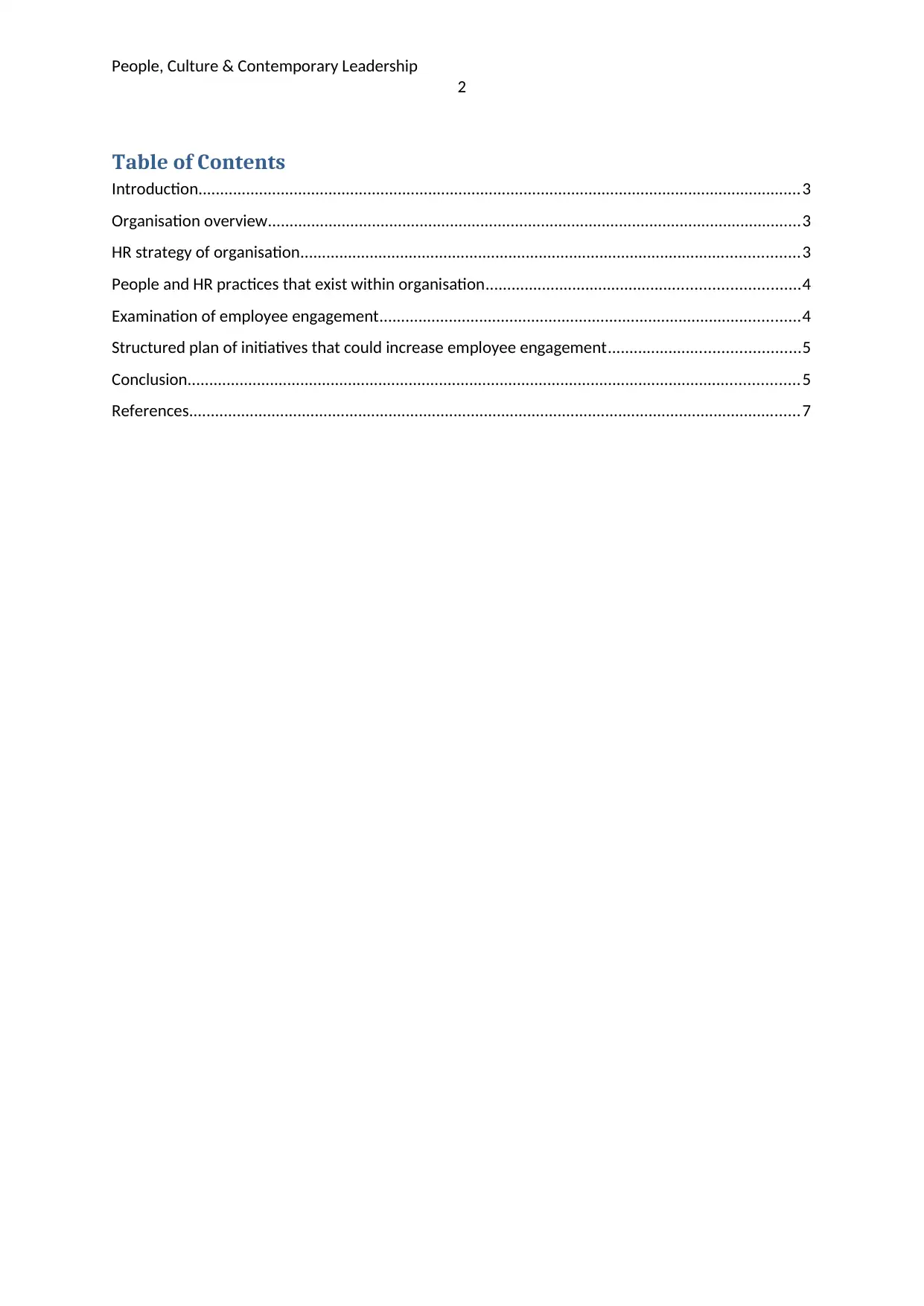
People, Culture & Contemporary Leadership
2
Table of Contents
Introduction...........................................................................................................................................3
Organisation overview...........................................................................................................................3
HR strategy of organisation...................................................................................................................3
People and HR practices that exist within organisation........................................................................4
Examination of employee engagement.................................................................................................4
Structured plan of initiatives that could increase employee engagement............................................5
Conclusion.............................................................................................................................................5
References.............................................................................................................................................7
2
Table of Contents
Introduction...........................................................................................................................................3
Organisation overview...........................................................................................................................3
HR strategy of organisation...................................................................................................................3
People and HR practices that exist within organisation........................................................................4
Examination of employee engagement.................................................................................................4
Structured plan of initiatives that could increase employee engagement............................................5
Conclusion.............................................................................................................................................5
References.............................................................................................................................................7
⊘ This is a preview!⊘
Do you want full access?
Subscribe today to unlock all pages.

Trusted by 1+ million students worldwide
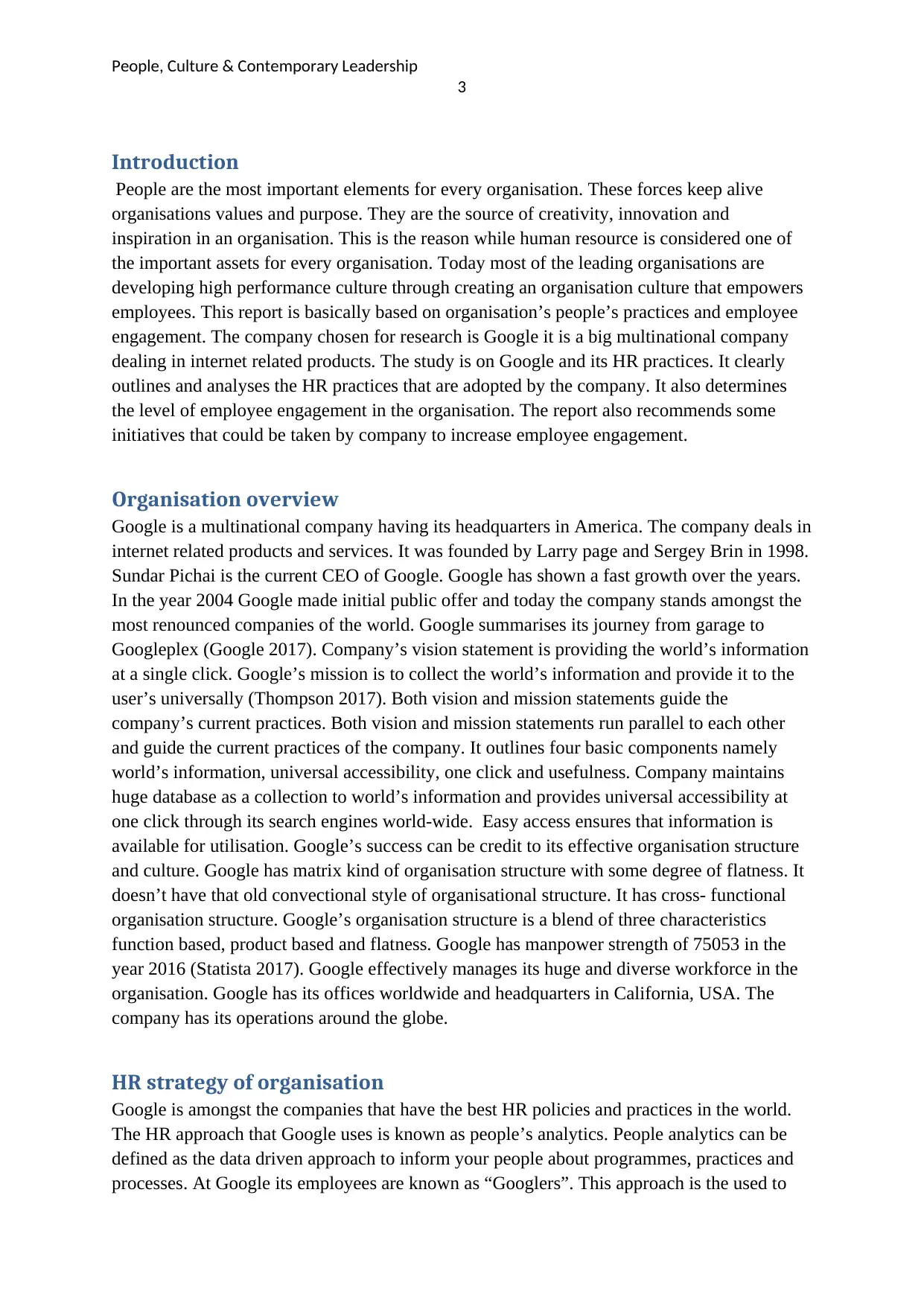
People, Culture & Contemporary Leadership
3
Introduction
People are the most important elements for every organisation. These forces keep alive
organisations values and purpose. They are the source of creativity, innovation and
inspiration in an organisation. This is the reason while human resource is considered one of
the important assets for every organisation. Today most of the leading organisations are
developing high performance culture through creating an organisation culture that empowers
employees. This report is basically based on organisation’s people’s practices and employee
engagement. The company chosen for research is Google it is a big multinational company
dealing in internet related products. The study is on Google and its HR practices. It clearly
outlines and analyses the HR practices that are adopted by the company. It also determines
the level of employee engagement in the organisation. The report also recommends some
initiatives that could be taken by company to increase employee engagement.
Organisation overview
Google is a multinational company having its headquarters in America. The company deals in
internet related products and services. It was founded by Larry page and Sergey Brin in 1998.
Sundar Pichai is the current CEO of Google. Google has shown a fast growth over the years.
In the year 2004 Google made initial public offer and today the company stands amongst the
most renounced companies of the world. Google summarises its journey from garage to
Googleplex (Google 2017). Company’s vision statement is providing the world’s information
at a single click. Google’s mission is to collect the world’s information and provide it to the
user’s universally (Thompson 2017). Both vision and mission statements guide the
company’s current practices. Both vision and mission statements run parallel to each other
and guide the current practices of the company. It outlines four basic components namely
world’s information, universal accessibility, one click and usefulness. Company maintains
huge database as a collection to world’s information and provides universal accessibility at
one click through its search engines world-wide. Easy access ensures that information is
available for utilisation. Google’s success can be credit to its effective organisation structure
and culture. Google has matrix kind of organisation structure with some degree of flatness. It
doesn’t have that old convectional style of organisational structure. It has cross- functional
organisation structure. Google’s organisation structure is a blend of three characteristics
function based, product based and flatness. Google has manpower strength of 75053 in the
year 2016 (Statista 2017). Google effectively manages its huge and diverse workforce in the
organisation. Google has its offices worldwide and headquarters in California, USA. The
company has its operations around the globe.
HR strategy of organisation
Google is amongst the companies that have the best HR policies and practices in the world.
The HR approach that Google uses is known as people’s analytics. People analytics can be
defined as the data driven approach to inform your people about programmes, practices and
processes. At Google its employees are known as “Googlers”. This approach is the used to
3
Introduction
People are the most important elements for every organisation. These forces keep alive
organisations values and purpose. They are the source of creativity, innovation and
inspiration in an organisation. This is the reason while human resource is considered one of
the important assets for every organisation. Today most of the leading organisations are
developing high performance culture through creating an organisation culture that empowers
employees. This report is basically based on organisation’s people’s practices and employee
engagement. The company chosen for research is Google it is a big multinational company
dealing in internet related products. The study is on Google and its HR practices. It clearly
outlines and analyses the HR practices that are adopted by the company. It also determines
the level of employee engagement in the organisation. The report also recommends some
initiatives that could be taken by company to increase employee engagement.
Organisation overview
Google is a multinational company having its headquarters in America. The company deals in
internet related products and services. It was founded by Larry page and Sergey Brin in 1998.
Sundar Pichai is the current CEO of Google. Google has shown a fast growth over the years.
In the year 2004 Google made initial public offer and today the company stands amongst the
most renounced companies of the world. Google summarises its journey from garage to
Googleplex (Google 2017). Company’s vision statement is providing the world’s information
at a single click. Google’s mission is to collect the world’s information and provide it to the
user’s universally (Thompson 2017). Both vision and mission statements guide the
company’s current practices. Both vision and mission statements run parallel to each other
and guide the current practices of the company. It outlines four basic components namely
world’s information, universal accessibility, one click and usefulness. Company maintains
huge database as a collection to world’s information and provides universal accessibility at
one click through its search engines world-wide. Easy access ensures that information is
available for utilisation. Google’s success can be credit to its effective organisation structure
and culture. Google has matrix kind of organisation structure with some degree of flatness. It
doesn’t have that old convectional style of organisational structure. It has cross- functional
organisation structure. Google’s organisation structure is a blend of three characteristics
function based, product based and flatness. Google has manpower strength of 75053 in the
year 2016 (Statista 2017). Google effectively manages its huge and diverse workforce in the
organisation. Google has its offices worldwide and headquarters in California, USA. The
company has its operations around the globe.
HR strategy of organisation
Google is amongst the companies that have the best HR policies and practices in the world.
The HR approach that Google uses is known as people’s analytics. People analytics can be
defined as the data driven approach to inform your people about programmes, practices and
processes. At Google its employees are known as “Googlers”. This approach is the used to
Paraphrase This Document
Need a fresh take? Get an instant paraphrase of this document with our AI Paraphraser
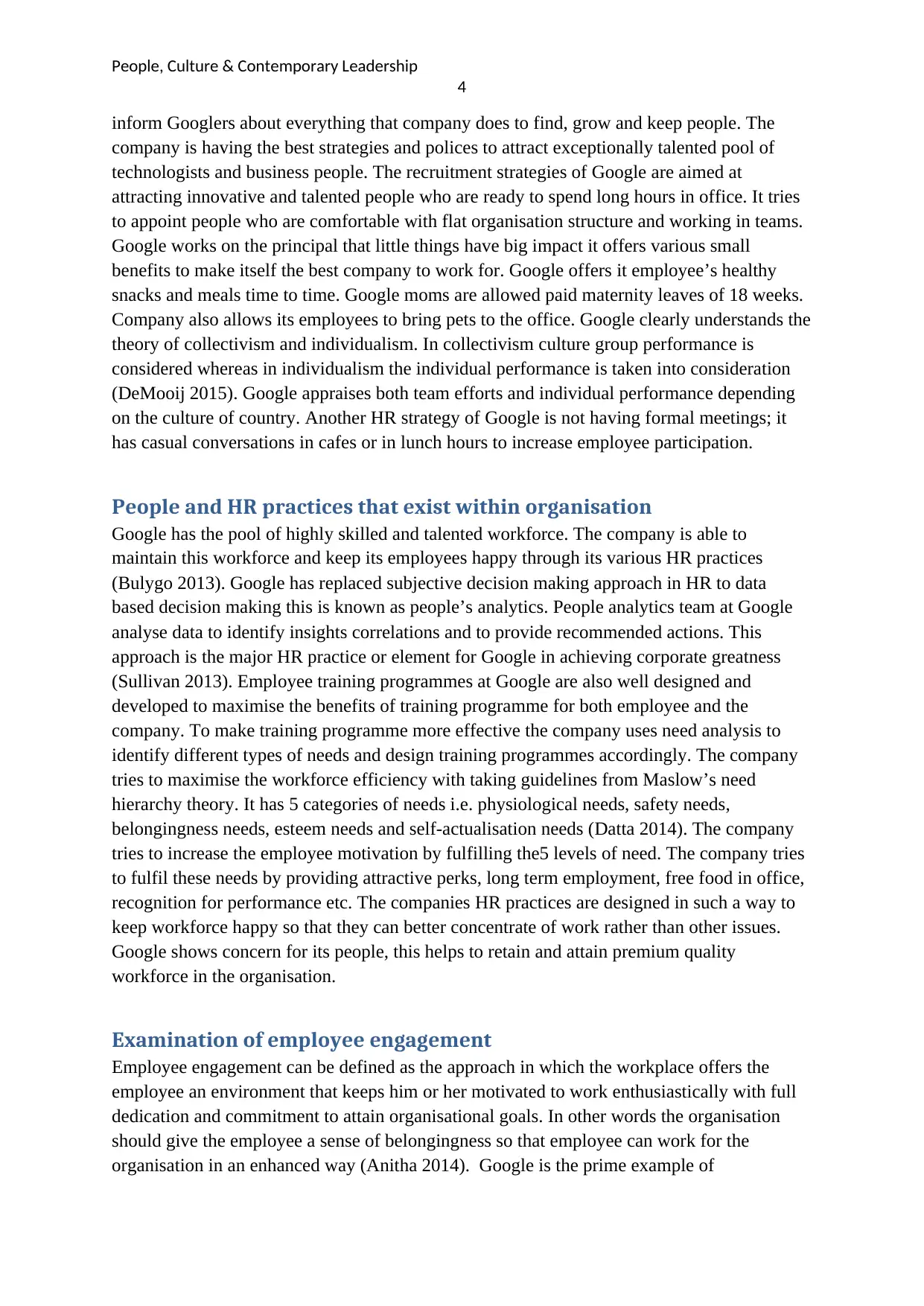
People, Culture & Contemporary Leadership
4
inform Googlers about everything that company does to find, grow and keep people. The
company is having the best strategies and polices to attract exceptionally talented pool of
technologists and business people. The recruitment strategies of Google are aimed at
attracting innovative and talented people who are ready to spend long hours in office. It tries
to appoint people who are comfortable with flat organisation structure and working in teams.
Google works on the principal that little things have big impact it offers various small
benefits to make itself the best company to work for. Google offers it employee’s healthy
snacks and meals time to time. Google moms are allowed paid maternity leaves of 18 weeks.
Company also allows its employees to bring pets to the office. Google clearly understands the
theory of collectivism and individualism. In collectivism culture group performance is
considered whereas in individualism the individual performance is taken into consideration
(DeMooij 2015). Google appraises both team efforts and individual performance depending
on the culture of country. Another HR strategy of Google is not having formal meetings; it
has casual conversations in cafes or in lunch hours to increase employee participation.
People and HR practices that exist within organisation
Google has the pool of highly skilled and talented workforce. The company is able to
maintain this workforce and keep its employees happy through its various HR practices
(Bulygo 2013). Google has replaced subjective decision making approach in HR to data
based decision making this is known as people’s analytics. People analytics team at Google
analyse data to identify insights correlations and to provide recommended actions. This
approach is the major HR practice or element for Google in achieving corporate greatness
(Sullivan 2013). Employee training programmes at Google are also well designed and
developed to maximise the benefits of training programme for both employee and the
company. To make training programme more effective the company uses need analysis to
identify different types of needs and design training programmes accordingly. The company
tries to maximise the workforce efficiency with taking guidelines from Maslow’s need
hierarchy theory. It has 5 categories of needs i.e. physiological needs, safety needs,
belongingness needs, esteem needs and self-actualisation needs (Datta 2014). The company
tries to increase the employee motivation by fulfilling the5 levels of need. The company tries
to fulfil these needs by providing attractive perks, long term employment, free food in office,
recognition for performance etc. The companies HR practices are designed in such a way to
keep workforce happy so that they can better concentrate of work rather than other issues.
Google shows concern for its people, this helps to retain and attain premium quality
workforce in the organisation.
Examination of employee engagement
Employee engagement can be defined as the approach in which the workplace offers the
employee an environment that keeps him or her motivated to work enthusiastically with full
dedication and commitment to attain organisational goals. In other words the organisation
should give the employee a sense of belongingness so that employee can work for the
organisation in an enhanced way (Anitha 2014). Google is the prime example of
4
inform Googlers about everything that company does to find, grow and keep people. The
company is having the best strategies and polices to attract exceptionally talented pool of
technologists and business people. The recruitment strategies of Google are aimed at
attracting innovative and talented people who are ready to spend long hours in office. It tries
to appoint people who are comfortable with flat organisation structure and working in teams.
Google works on the principal that little things have big impact it offers various small
benefits to make itself the best company to work for. Google offers it employee’s healthy
snacks and meals time to time. Google moms are allowed paid maternity leaves of 18 weeks.
Company also allows its employees to bring pets to the office. Google clearly understands the
theory of collectivism and individualism. In collectivism culture group performance is
considered whereas in individualism the individual performance is taken into consideration
(DeMooij 2015). Google appraises both team efforts and individual performance depending
on the culture of country. Another HR strategy of Google is not having formal meetings; it
has casual conversations in cafes or in lunch hours to increase employee participation.
People and HR practices that exist within organisation
Google has the pool of highly skilled and talented workforce. The company is able to
maintain this workforce and keep its employees happy through its various HR practices
(Bulygo 2013). Google has replaced subjective decision making approach in HR to data
based decision making this is known as people’s analytics. People analytics team at Google
analyse data to identify insights correlations and to provide recommended actions. This
approach is the major HR practice or element for Google in achieving corporate greatness
(Sullivan 2013). Employee training programmes at Google are also well designed and
developed to maximise the benefits of training programme for both employee and the
company. To make training programme more effective the company uses need analysis to
identify different types of needs and design training programmes accordingly. The company
tries to maximise the workforce efficiency with taking guidelines from Maslow’s need
hierarchy theory. It has 5 categories of needs i.e. physiological needs, safety needs,
belongingness needs, esteem needs and self-actualisation needs (Datta 2014). The company
tries to increase the employee motivation by fulfilling the5 levels of need. The company tries
to fulfil these needs by providing attractive perks, long term employment, free food in office,
recognition for performance etc. The companies HR practices are designed in such a way to
keep workforce happy so that they can better concentrate of work rather than other issues.
Google shows concern for its people, this helps to retain and attain premium quality
workforce in the organisation.
Examination of employee engagement
Employee engagement can be defined as the approach in which the workplace offers the
employee an environment that keeps him or her motivated to work enthusiastically with full
dedication and commitment to attain organisational goals. In other words the organisation
should give the employee a sense of belongingness so that employee can work for the
organisation in an enhanced way (Anitha 2014). Google is the prime example of
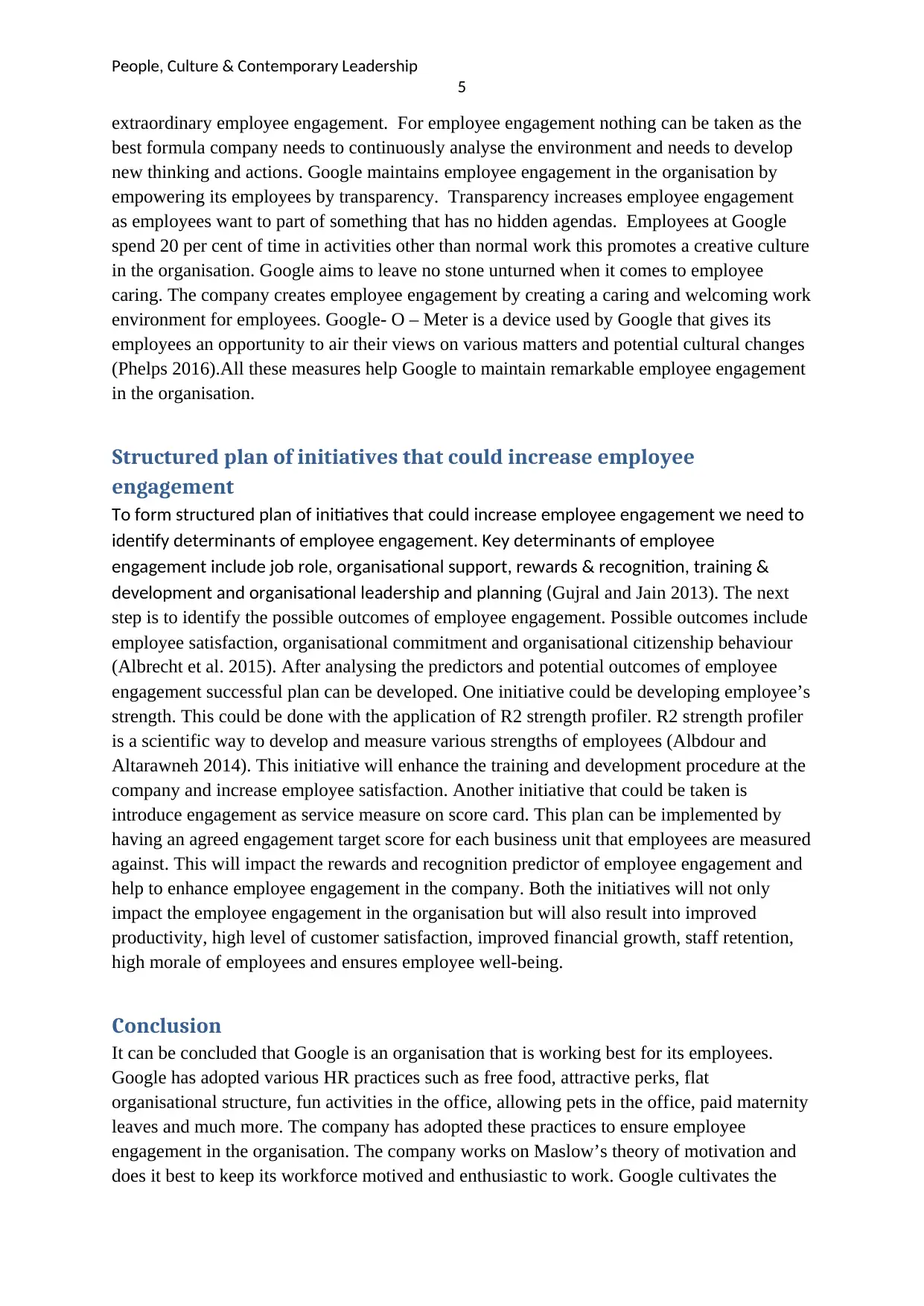
People, Culture & Contemporary Leadership
5
extraordinary employee engagement. For employee engagement nothing can be taken as the
best formula company needs to continuously analyse the environment and needs to develop
new thinking and actions. Google maintains employee engagement in the organisation by
empowering its employees by transparency. Transparency increases employee engagement
as employees want to part of something that has no hidden agendas. Employees at Google
spend 20 per cent of time in activities other than normal work this promotes a creative culture
in the organisation. Google aims to leave no stone unturned when it comes to employee
caring. The company creates employee engagement by creating a caring and welcoming work
environment for employees. Google- O – Meter is a device used by Google that gives its
employees an opportunity to air their views on various matters and potential cultural changes
(Phelps 2016).All these measures help Google to maintain remarkable employee engagement
in the organisation.
Structured plan of initiatives that could increase employee
engagement
To form structured plan of initiatives that could increase employee engagement we need to
identify determinants of employee engagement. Key determinants of employee
engagement include job role, organisational support, rewards & recognition, training &
development and organisational leadership and planning (Gujral and Jain 2013). The next
step is to identify the possible outcomes of employee engagement. Possible outcomes include
employee satisfaction, organisational commitment and organisational citizenship behaviour
(Albrecht et al. 2015). After analysing the predictors and potential outcomes of employee
engagement successful plan can be developed. One initiative could be developing employee’s
strength. This could be done with the application of R2 strength profiler. R2 strength profiler
is a scientific way to develop and measure various strengths of employees (Albdour and
Altarawneh 2014). This initiative will enhance the training and development procedure at the
company and increase employee satisfaction. Another initiative that could be taken is
introduce engagement as service measure on score card. This plan can be implemented by
having an agreed engagement target score for each business unit that employees are measured
against. This will impact the rewards and recognition predictor of employee engagement and
help to enhance employee engagement in the company. Both the initiatives will not only
impact the employee engagement in the organisation but will also result into improved
productivity, high level of customer satisfaction, improved financial growth, staff retention,
high morale of employees and ensures employee well-being.
Conclusion
It can be concluded that Google is an organisation that is working best for its employees.
Google has adopted various HR practices such as free food, attractive perks, flat
organisational structure, fun activities in the office, allowing pets in the office, paid maternity
leaves and much more. The company has adopted these practices to ensure employee
engagement in the organisation. The company works on Maslow’s theory of motivation and
does it best to keep its workforce motived and enthusiastic to work. Google cultivates the
5
extraordinary employee engagement. For employee engagement nothing can be taken as the
best formula company needs to continuously analyse the environment and needs to develop
new thinking and actions. Google maintains employee engagement in the organisation by
empowering its employees by transparency. Transparency increases employee engagement
as employees want to part of something that has no hidden agendas. Employees at Google
spend 20 per cent of time in activities other than normal work this promotes a creative culture
in the organisation. Google aims to leave no stone unturned when it comes to employee
caring. The company creates employee engagement by creating a caring and welcoming work
environment for employees. Google- O – Meter is a device used by Google that gives its
employees an opportunity to air their views on various matters and potential cultural changes
(Phelps 2016).All these measures help Google to maintain remarkable employee engagement
in the organisation.
Structured plan of initiatives that could increase employee
engagement
To form structured plan of initiatives that could increase employee engagement we need to
identify determinants of employee engagement. Key determinants of employee
engagement include job role, organisational support, rewards & recognition, training &
development and organisational leadership and planning (Gujral and Jain 2013). The next
step is to identify the possible outcomes of employee engagement. Possible outcomes include
employee satisfaction, organisational commitment and organisational citizenship behaviour
(Albrecht et al. 2015). After analysing the predictors and potential outcomes of employee
engagement successful plan can be developed. One initiative could be developing employee’s
strength. This could be done with the application of R2 strength profiler. R2 strength profiler
is a scientific way to develop and measure various strengths of employees (Albdour and
Altarawneh 2014). This initiative will enhance the training and development procedure at the
company and increase employee satisfaction. Another initiative that could be taken is
introduce engagement as service measure on score card. This plan can be implemented by
having an agreed engagement target score for each business unit that employees are measured
against. This will impact the rewards and recognition predictor of employee engagement and
help to enhance employee engagement in the company. Both the initiatives will not only
impact the employee engagement in the organisation but will also result into improved
productivity, high level of customer satisfaction, improved financial growth, staff retention,
high morale of employees and ensures employee well-being.
Conclusion
It can be concluded that Google is an organisation that is working best for its employees.
Google has adopted various HR practices such as free food, attractive perks, flat
organisational structure, fun activities in the office, allowing pets in the office, paid maternity
leaves and much more. The company has adopted these practices to ensure employee
engagement in the organisation. The company works on Maslow’s theory of motivation and
does it best to keep its workforce motived and enthusiastic to work. Google cultivates the
⊘ This is a preview!⊘
Do you want full access?
Subscribe today to unlock all pages.

Trusted by 1+ million students worldwide
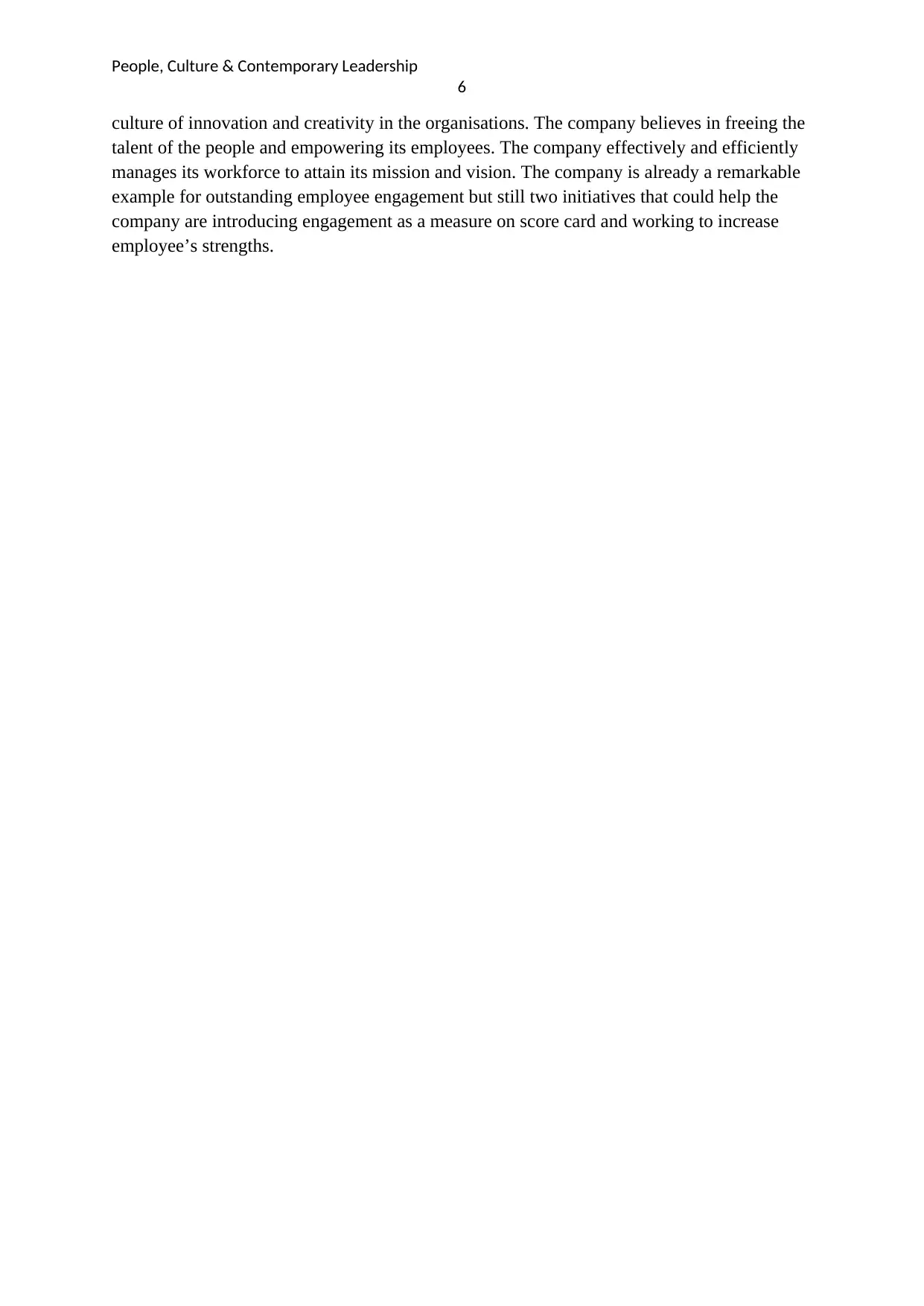
People, Culture & Contemporary Leadership
6
culture of innovation and creativity in the organisations. The company believes in freeing the
talent of the people and empowering its employees. The company effectively and efficiently
manages its workforce to attain its mission and vision. The company is already a remarkable
example for outstanding employee engagement but still two initiatives that could help the
company are introducing engagement as a measure on score card and working to increase
employee’s strengths.
6
culture of innovation and creativity in the organisations. The company believes in freeing the
talent of the people and empowering its employees. The company effectively and efficiently
manages its workforce to attain its mission and vision. The company is already a remarkable
example for outstanding employee engagement but still two initiatives that could help the
company are introducing engagement as a measure on score card and working to increase
employee’s strengths.
Paraphrase This Document
Need a fresh take? Get an instant paraphrase of this document with our AI Paraphraser
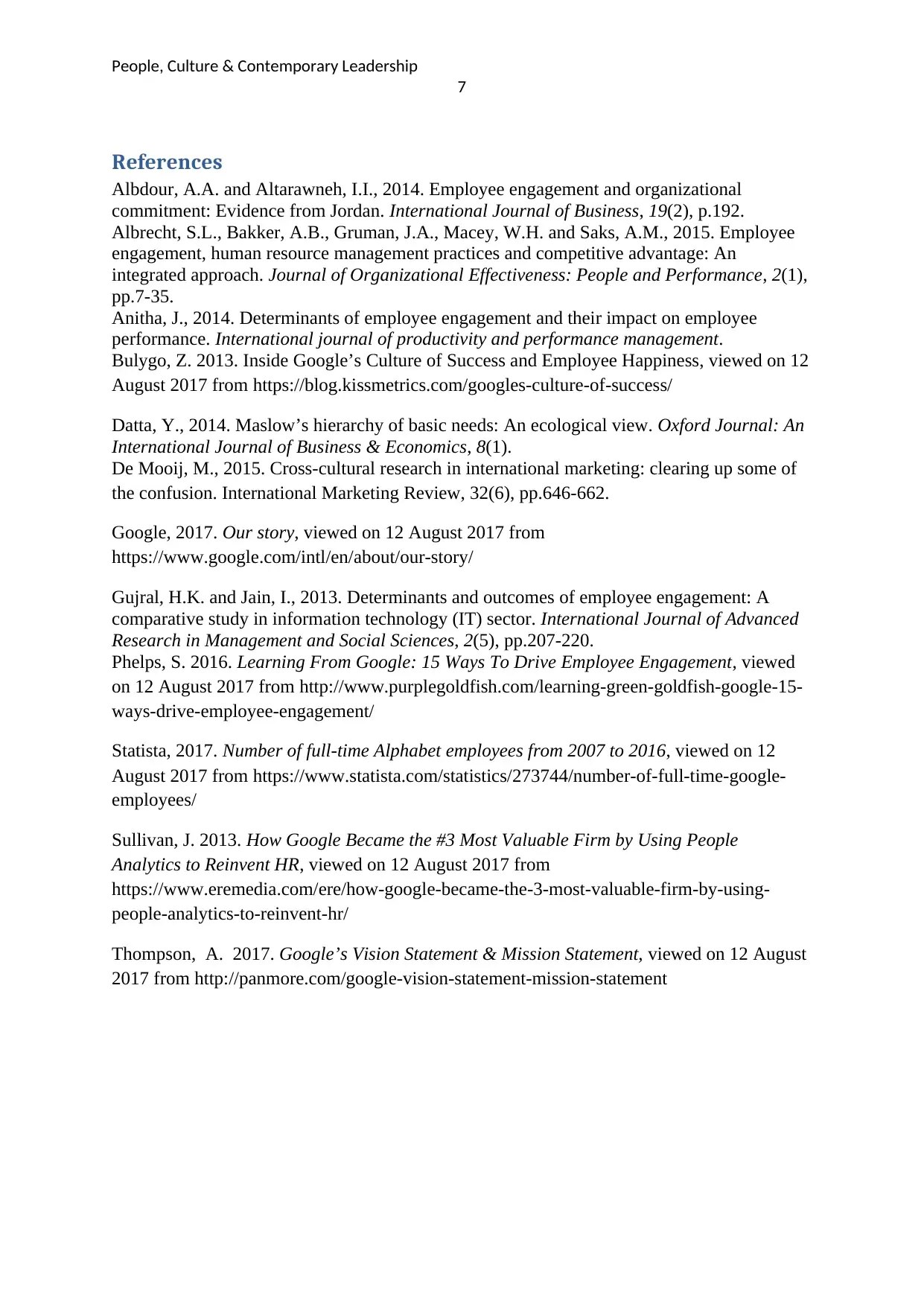
People, Culture & Contemporary Leadership
7
References
Albdour, A.A. and Altarawneh, I.I., 2014. Employee engagement and organizational
commitment: Evidence from Jordan. International Journal of Business, 19(2), p.192.
Albrecht, S.L., Bakker, A.B., Gruman, J.A., Macey, W.H. and Saks, A.M., 2015. Employee
engagement, human resource management practices and competitive advantage: An
integrated approach. Journal of Organizational Effectiveness: People and Performance, 2(1),
pp.7-35.
Anitha, J., 2014. Determinants of employee engagement and their impact on employee
performance. International journal of productivity and performance management.
Bulygo, Z. 2013. Inside Google’s Culture of Success and Employee Happiness, viewed on 12
August 2017 from https://blog.kissmetrics.com/googles-culture-of-success/
Datta, Y., 2014. Maslow’s hierarchy of basic needs: An ecological view. Oxford Journal: An
International Journal of Business & Economics, 8(1).
De Mooij, M., 2015. Cross-cultural research in international marketing: clearing up some of
the confusion. International Marketing Review, 32(6), pp.646-662.
Google, 2017. Our story, viewed on 12 August 2017 from
https://www.google.com/intl/en/about/our-story/
Gujral, H.K. and Jain, I., 2013. Determinants and outcomes of employee engagement: A
comparative study in information technology (IT) sector. International Journal of Advanced
Research in Management and Social Sciences, 2(5), pp.207-220.
Phelps, S. 2016. Learning From Google: 15 Ways To Drive Employee Engagement, viewed
on 12 August 2017 from http://www.purplegoldfish.com/learning-green-goldfish-google-15-
ways-drive-employee-engagement/
Statista, 2017. Number of full-time Alphabet employees from 2007 to 2016, viewed on 12
August 2017 from https://www.statista.com/statistics/273744/number-of-full-time-google-
employees/
Sullivan, J. 2013. How Google Became the #3 Most Valuable Firm by Using People
Analytics to Reinvent HR, viewed on 12 August 2017 from
https://www.eremedia.com/ere/how-google-became-the-3-most-valuable-firm-by-using-
people-analytics-to-reinvent-hr/
Thompson, A. 2017. Google’s Vision Statement & Mission Statement, viewed on 12 August
2017 from http://panmore.com/google-vision-statement-mission-statement
7
References
Albdour, A.A. and Altarawneh, I.I., 2014. Employee engagement and organizational
commitment: Evidence from Jordan. International Journal of Business, 19(2), p.192.
Albrecht, S.L., Bakker, A.B., Gruman, J.A., Macey, W.H. and Saks, A.M., 2015. Employee
engagement, human resource management practices and competitive advantage: An
integrated approach. Journal of Organizational Effectiveness: People and Performance, 2(1),
pp.7-35.
Anitha, J., 2014. Determinants of employee engagement and their impact on employee
performance. International journal of productivity and performance management.
Bulygo, Z. 2013. Inside Google’s Culture of Success and Employee Happiness, viewed on 12
August 2017 from https://blog.kissmetrics.com/googles-culture-of-success/
Datta, Y., 2014. Maslow’s hierarchy of basic needs: An ecological view. Oxford Journal: An
International Journal of Business & Economics, 8(1).
De Mooij, M., 2015. Cross-cultural research in international marketing: clearing up some of
the confusion. International Marketing Review, 32(6), pp.646-662.
Google, 2017. Our story, viewed on 12 August 2017 from
https://www.google.com/intl/en/about/our-story/
Gujral, H.K. and Jain, I., 2013. Determinants and outcomes of employee engagement: A
comparative study in information technology (IT) sector. International Journal of Advanced
Research in Management and Social Sciences, 2(5), pp.207-220.
Phelps, S. 2016. Learning From Google: 15 Ways To Drive Employee Engagement, viewed
on 12 August 2017 from http://www.purplegoldfish.com/learning-green-goldfish-google-15-
ways-drive-employee-engagement/
Statista, 2017. Number of full-time Alphabet employees from 2007 to 2016, viewed on 12
August 2017 from https://www.statista.com/statistics/273744/number-of-full-time-google-
employees/
Sullivan, J. 2013. How Google Became the #3 Most Valuable Firm by Using People
Analytics to Reinvent HR, viewed on 12 August 2017 from
https://www.eremedia.com/ere/how-google-became-the-3-most-valuable-firm-by-using-
people-analytics-to-reinvent-hr/
Thompson, A. 2017. Google’s Vision Statement & Mission Statement, viewed on 12 August
2017 from http://panmore.com/google-vision-statement-mission-statement
1 out of 8
Related Documents
Your All-in-One AI-Powered Toolkit for Academic Success.
+13062052269
info@desklib.com
Available 24*7 on WhatsApp / Email
![[object Object]](/_next/static/media/star-bottom.7253800d.svg)
Unlock your academic potential
Copyright © 2020–2025 A2Z Services. All Rights Reserved. Developed and managed by ZUCOL.





